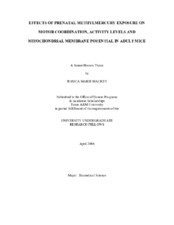| dc.description.abstract | Methylmercury has cytotoxic effects on animals and humans and a major target
organ for methylmercury is the central nervous system (CNS). Methylmercury
(MeHg) is a developmental neurotoxicant and the prenatal CNS appears to be even more sensitive to MeHg than the mature CNS. Previous research has shown that high doses of MeHg have severe cellular and behavioral effects. More recently, concern has been raised with respect to possible deleterious effects of chronic low doses of MeHg exposure to the developing CNS. The objective of this study was to determine if chronic low dose MeHg exposure would result in deficits in cognition and coordination and a decrease in mitochondrial membrane potential in cerebellar granule cells. Pregnant mice were divided into control and treatment groups. Developing fetuses were exposed to chronic low doses of MeHg through feeding food containing MeHg to pregnant C57Bl/6J female mice at a daily dose of 0.03 µg/Kg of body weight. Footprint analysis, rota-rod, vertical pole, open field and Morris water maze were used to test for changes in coordination, activity levels, spatial learning and memory. Differences were observed between control and MeHg groups in rota-rod, footprint analysis, open field and Morris water maze. The results follow below. Controls stayed on the rota-rod twice as long as treated mice on the last day of trials. Left and right foot angles were decreased in treated mice. Treated females displayed less rearing movement in the first five minutes of open field compared to both treated males and the controls. In the Morris water maze, treated mice took longer than controls to find the platform on days 1-4. The probe trial results indicated that treated mice swam significantly less than the controls.
Cerebellar granule cells were isolated using dissociation media containing DNAse, and mitochondrial membrane potential was measured on the acutely isolated cells using tetramethylrhodamine methylester fluorescent dye. Images were captured with a fluorescence microscope. The data indicated no significant differences in fluorescence between control and MeHg mice.
These conclusions indicate prenatal in vivo methylmercury exposure in mice may not significantly impair mitochondrial membrane potential; however, other abnormal neuronal functions lead to the subtle changes in motor and cognitive behavior described in this research. As a consequence, other cellular mechanisms must be delineated to understand how prenatal methylmercury exposure causes CNS pathogenesis. | en |


